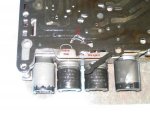fletcher969
Member
- Joined
- Jun 15, 2011
- Messages
- 48
- Reaction score
- 0
- Points
- 6
- Location
- Chicago, IL
- Vehicle Year
- 1998
- Make / Model
- Ford
- Engine Size
- 3.0L
- Transmission
- Automatic
Hi all,
Huge problem as my primary vehicle isn't moving. I'm pretty handy with the tools, and I'm a quick study, so any advice will be helpful. I'm hoping there might be something in what I describe that will help somebody identify the primary (possible) causes of what's described below. Here are the basics:
1996 XLT
191,000 miles
2.3L 2WD
4R44E Tranny
...2-3 flare for the last 3-4 months
...harsh in reverse (slow, jerky engagement, some shudders, undulating RPMs, runs fine "at speed")
...all other gears operate(d) as expected, including OD
About 2 weeks ago I started to notice some differences in my tranny.
...Very very sporadically, 1st wouldn't engage immediately from an idle stop
...noticed a small drip-leak from the tail housing near/at the driveshaft
...2-3 flare seemed to be "slippery" compared to before (seemed to want to flare more easily)
Today I was driving down the road, and before it was at operating temperature, I noticed it wanted to flare a little earlier than usual, and seemed to want to flare again (slip?) after it had shifted, but aside from that, it handled a fairly aggressive acceleration as I got up to speed. About 5 minutes later, without any additional symptoms, and without notice, it instantaneously lost all forward gears shortly after I shifted into 3rd or possibly 4th gear. So far as I can tell, no amount of time or RPMs will cause any forward gear to engage, nor does manually selection of gears. Also, there was no occurence of limp mode or the OD light flashing. No physical signs of damage underneath, fluid level is fine (slightly over-filled actually), color is clear and red. Reverse operates exactly as it did previously.
Again, any suggestions would be greatly appreciated as this is going to quickly cramp my days.
Thanks.
Dave
Day 2 Update: I started my truck this morning, and immediately put it into drive. Initially it started inching forward, but stopped after about 6", and didn't move thereafter in D, 2, or 1. I turned off the OD as was suggested on a different forum, but it affected no change. The tranny seems to be holding the truck in place (i.e. it's on a slight slope, and it won't coast backwards), but it won't move it forward. Hope this proves somewhat helpful.
Huge problem as my primary vehicle isn't moving. I'm pretty handy with the tools, and I'm a quick study, so any advice will be helpful. I'm hoping there might be something in what I describe that will help somebody identify the primary (possible) causes of what's described below. Here are the basics:
1996 XLT
191,000 miles
2.3L 2WD
4R44E Tranny
...2-3 flare for the last 3-4 months
...harsh in reverse (slow, jerky engagement, some shudders, undulating RPMs, runs fine "at speed")
...all other gears operate(d) as expected, including OD
About 2 weeks ago I started to notice some differences in my tranny.
...Very very sporadically, 1st wouldn't engage immediately from an idle stop
...noticed a small drip-leak from the tail housing near/at the driveshaft
...2-3 flare seemed to be "slippery" compared to before (seemed to want to flare more easily)
Today I was driving down the road, and before it was at operating temperature, I noticed it wanted to flare a little earlier than usual, and seemed to want to flare again (slip?) after it had shifted, but aside from that, it handled a fairly aggressive acceleration as I got up to speed. About 5 minutes later, without any additional symptoms, and without notice, it instantaneously lost all forward gears shortly after I shifted into 3rd or possibly 4th gear. So far as I can tell, no amount of time or RPMs will cause any forward gear to engage, nor does manually selection of gears. Also, there was no occurence of limp mode or the OD light flashing. No physical signs of damage underneath, fluid level is fine (slightly over-filled actually), color is clear and red. Reverse operates exactly as it did previously.
Again, any suggestions would be greatly appreciated as this is going to quickly cramp my days.
Thanks.
Dave
Day 2 Update: I started my truck this morning, and immediately put it into drive. Initially it started inching forward, but stopped after about 6", and didn't move thereafter in D, 2, or 1. I turned off the OD as was suggested on a different forum, but it affected no change. The tranny seems to be holding the truck in place (i.e. it's on a slight slope, and it won't coast backwards), but it won't move it forward. Hope this proves somewhat helpful.
Last edited:















